In this article series, titled ‘Creating a Virtual Space’, I will introduce readers to what spatial designing in the virtual world is like.
I hope you will follow along as I introduce how to create new world scenes with STYLY.
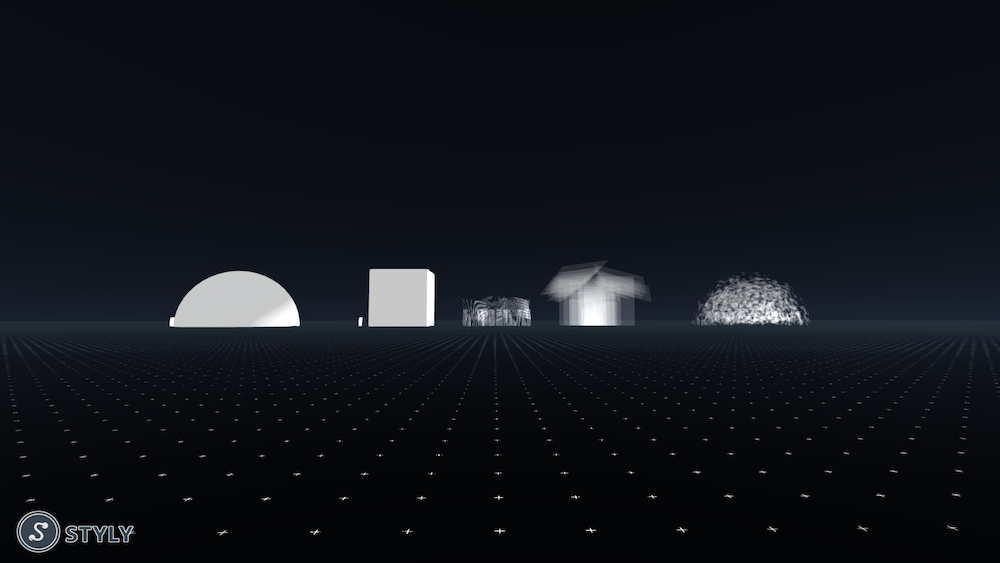
Extended Space Experiment
“Surface”
- 1 Sample
- 2 Paper-Thin Virtual Architecture – Part 1
- 3 What Is a Virtual Space?
- 4 Spatial Designing and Architecture Is More Familiar to Us Than You Think
- 5 Real or Virtual?
- 6 Virtual Architecture
- 7 Structures and Surfaces / Escaping from the Prison of Volume
- 8 Constructing Samples
- 9 Exceeding Reality with Virtual Reality
Sample
You can experience the scene created in this article in the STYLY GALLERY.
https://gallery.styly.cc/sabakichi/6e6493fb-723a-11e9-b34d-4783bb2170d0
If you own VR equipment you can use the VR version of STYLY or if you don’t you can view this scene using the desktop version. By reading this article and through exploring the scene you will be able to discover many new things.
You can download the Unity project used in this article from STYLY-Unity-Examples.
You will find all necessary material in the folder titled “Extended Space Experiment – Surface”.
Paper-Thin Virtual Architecture – Part 1
Hello, my name is sabakichi and I am an Extended Experience Designer.
Working as a Spatial Designer, I get to enjoy creating Virtual Scenes and Experiences in the virtual world. (‘Extended Experience Design’ is a word that I invented for a new way of thinking. This new way of thinking is needed for understanding ‘how to create and design new experiences in the new virtual era’.)
In this article series ‘Creating a virtual space’, I want to introduce readers to experiences in spatial designing in the virtual world. In each article, I will set a goal to explain the unique nature and richness of virtual spaces and the new potential that it holds.
For part 1 of my series, I want to talk about Architecture and spaces in the real world, and the virtual world. I will also go through a tutorial so that you can see what is possible in VR.
What Is a Virtual Space?
So, what is a virtual space?
A virtual space is an information area that is created using 3D models and 3D technology.
In order to access these virtual spaces one needs virtual reality equipment (such as Oculus or HTC VIVE). A ‘virtual space’ is the container for these new fictional experiences.
It is a sort of abstract idea, but I am sure you have seen such a scene in science fiction movies. For example, in the Matrix Trilogy mankind is sleeping continuously, but they are living and feeling inside a world almost as real as reality that is created using computers. The ‘computer generated world’ in this film is a virtual world created by virtual reality technology and there exists many spaces that form this world. Those spaces are the ‘virtual spaces’ I am talking about.
My introduction is longer than I intended, but this abstract / science fiction dream is now a real technology!
Currently, there is no solid answer to the question, ‘What is a virtual space?’. This is because people have only started to use virtual spaces. Yes, one can answer the basic concepts, but how it should be used and what experiences it can create is still unknown. The fact that one can try to search for the answer that nobody knows yet is another reason that creating virtual spaces is so interesting now.
Spatial Designing and Architecture Is More Familiar to Us Than You Think
Before going into details about ’spaces’, I have to explain Architecture. Nobody can explain about fashion before talking about clothes. So a space can not be explained without first talking about architecture.
The word ‘Architecture’ may seem bold and you may associate it with huge churches or large institutional buildings, but if you think about it the world and spaces we live in are all created from architecture. Any kind of artificial space is generally including some ideology of architecture. Building and designing may not seem familiar to most people, but this is not entirely true. If there are walls, a roof, a comfortable space, this is architecture and we all live in a world created by architecture. In this way architecture and space designing are very familiar things to us.
In order to live comfortably, we need food, clothing, and shelter. We change our clothes everyday and eat different food everyday, but we do not change our shelter or living space often. This is because buildings take time to construct and are expensive. But if we focus on our ‘living space’, things become much more familiar. For example, when we plan moving or ponder on how to place our furniture, one can realize how important space design is.
To simply put it, we cannot live without living space.
Are you sitting in front of your desk now? or are you relaxing on a sofa? By creating ‘a space we belong to’, we are able to put our mind at ease. A ‘space’ is not simply a ‘space’ to us. Anywhere that people feel a strong sense of belonging may be called a living space. Then, what creates such a place? The situation related to it? or the people related to it?
By examining these facts, we can see that the basic ideas of a ‘space’ originates from architecture, but there are numerous aspects to it. There is an old saying, ‘Everything is architecture’, but the act of creating and designing such spaces is the idea of Architecture. By studying and pondering architecture, I came to the conclusion that spaces can be created from anything.
For example, for an increasing number of people social media services such Twitter and Instagram is where they belong. When you look at your mental home across a screen, where does your consciousness exist? Is it inside the SNS server or in your smartphone? There is no ‘real’ space there, but a living space as a structure can exist. VR technology may be able to build and personalize such an ‘electronic space’.
Real or Virtual?
This whole article is becoming very complicated, so let’s stop here and think about what a virtual space is.
In the first part of my article, I talked about how a space is not limited to physical ones, but they may exist from various elements. A ‘space’ may be a mental space and such spaces previously only existed as data and only visible through devices such as a smartphone. But I believe that virtual technology may be able to create and visualize such spaces.
Or, we can make it more simple and imagine a 3D space for each SNS where people can communicate freely with each other. There are already such services in use and are called social VR services.
I’m sure that by now, you will agree that a space, whether it be physical or mental, holds the same meaning to whom it concerns.
I sometimes see people trying to compare real spaces and virtual spaces, but I think that is nonsense. What can you gain by comparing the internet or a game world with reality? It doesn’t matter if the space is physical or digital. It may even be in between, as in MR. Some people may even find virtual spaces much more precious.
In the near future, ‘how to create virtual spaces’ will become a much more popular question. This introduction is intended to share what I want and desire for new virtual spaces.
Virtual Architecture
Well then before we start constructing a virtual space, let’s sort out what we need.
For now, VR platforms such as STYLY use game engines for creating uses. (STYLY also supports creating via the web). Game engines combine 3D models with other elements to create worlds and spaces.
To create a real world space, an architect is needed. This is because a ‘space’ is a concept to show what “isn’t actually present”.
Take a cup for example which has a purpose of holding liquid so it does not spill. In order to achieve such a function, a cup is created so it has a space that holds nothing, but still has the possibility and potential of holding something.
For a space to exist, there has to be an architecture like a cup. (Of course, there may be exceptions).
In the physical world, there are many architectural styles such as wooden, steel frame, masonry, and so on. There are many reasons for this, but one large reason is because of geographical aspects and the physical environment. But in the virtual world, there are no limiting external factors. One can choose what environment he or she wants. Creators can construct completely new and pure virtual architectures.
Next, I will talk what forms a virtual world ‘cup’ could take.
Structures and Surfaces / Escaping from the Prison of Volume
What are the differences between real world and virtual place design? In this section, I will compare existing real world architectural styles to those in virtual, so you can see the differences with your own eyes and understand the reasoning behind them. (I use the term “real world” to mean the physical world that our bodies are living in).
If you simplify the basic concept of real world architecture, it eventually becomes a simple shelter. A shelter is constructed by a simple space separated from the outside by boundaries.
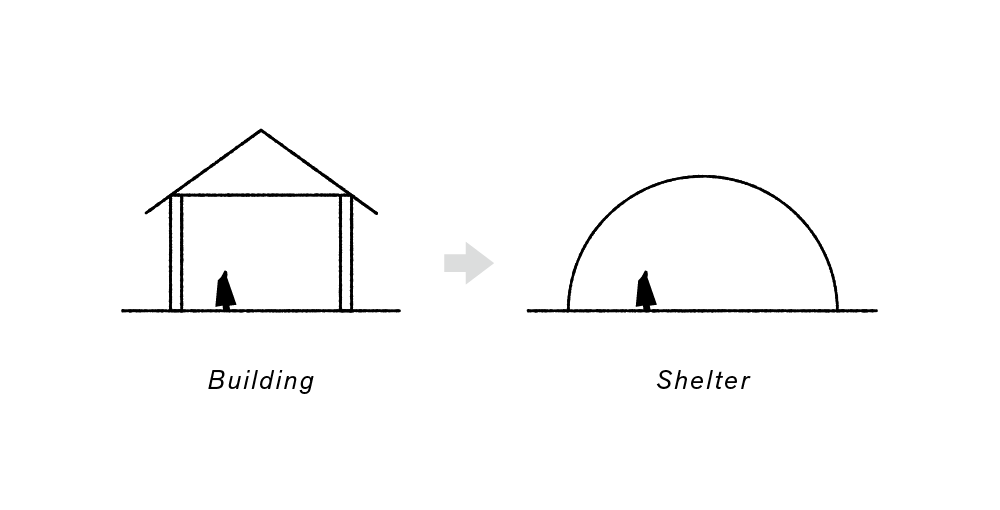
Conceptual diagram of shelter
Imagine a cave or a house made with just a roof.
An igloo made by children is a good example and shows how simple a shelter can be. A shelter is necessary and sufficient in the real world where humans need to protect themselves from enemies or from the wild.
Well then, what will a shelter look like in the virtual world?
Are there any enemies? In a social virtual platform, there may be. There is a possibility some cruel or heartless person could attack you in some way. But, unlike in the real world, there is little possibility that this enemy will be able to attack you physically. The need for a shelter as a form of protection may not be important compared to the real world. Instead, protecting yourself from view may be of higher importance in virtual spaces.
What about external environments? There is no need for this. You can even control physic laws in the virtual world. You could create harsh environments if you desire, but that is another story.
This means, a virtual space may be even simpler than a shelter.
Next, let’s think about the boundaries to separate the inside and the outside.
In the real world, boundaries are created using walls and roofs. By transforming objects it protects the inside from external factors. Because of this, there has to be some amount of volume in order to act as protection.
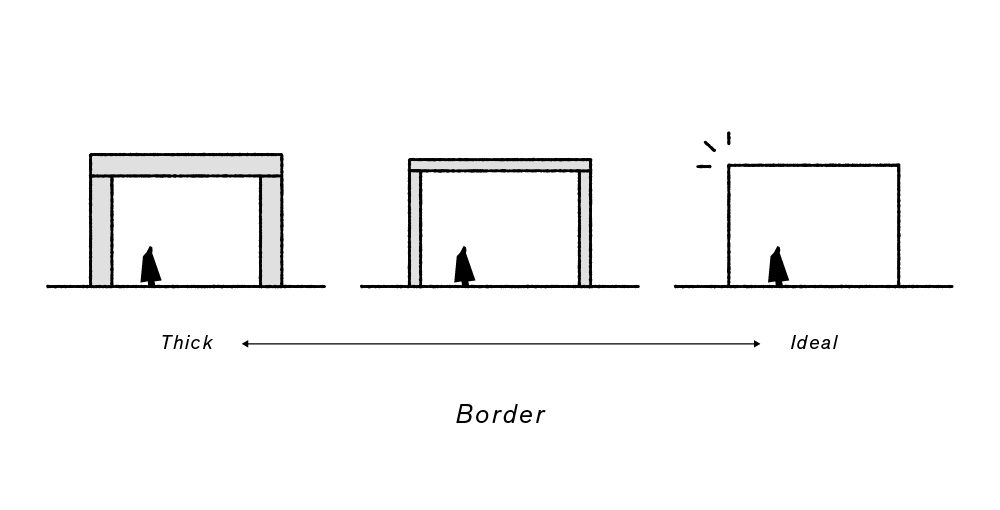
Ideal and realistic border volumes
Ideally, you want to make borders as thin as paper, however these thin borders may not be enough in the real world. But this is not true in the virtual world. There are no external factors, meaning you could use paper-thin walls as boundaries.
Virtual worlds are made from surfaces. 3D models do not have any volume. Since no one can see through polygons, no volume is needed inside. (To be precise, there are certain industrial models that have volume, but we will ignore that for now)
So, all the 3D models you see in the virtual world have pseudo volume, but are in truth paper-thin existences. Ideal borders for a shelter are paper-thin walls and because of this you can see how that can be achieved easily in a virtual world.
Let’s try and see what a space created from paper-thin surfaces looks like.
Constructing Samples
Let’s think what creating a space with just surfaces is like.
A simple examples would be a dome shaped shelter or a box shaped shelter.
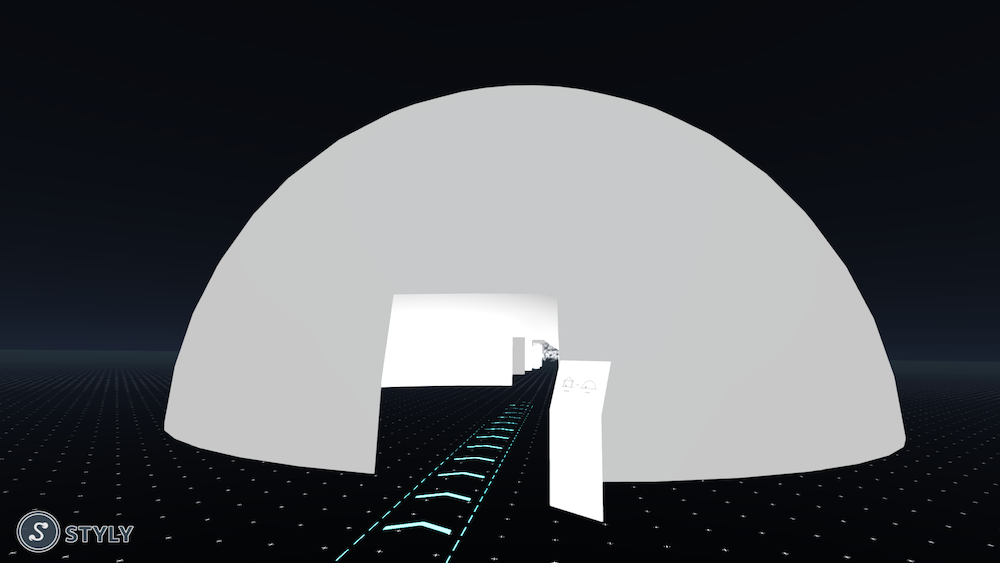
A simple dome shaped virtual construction
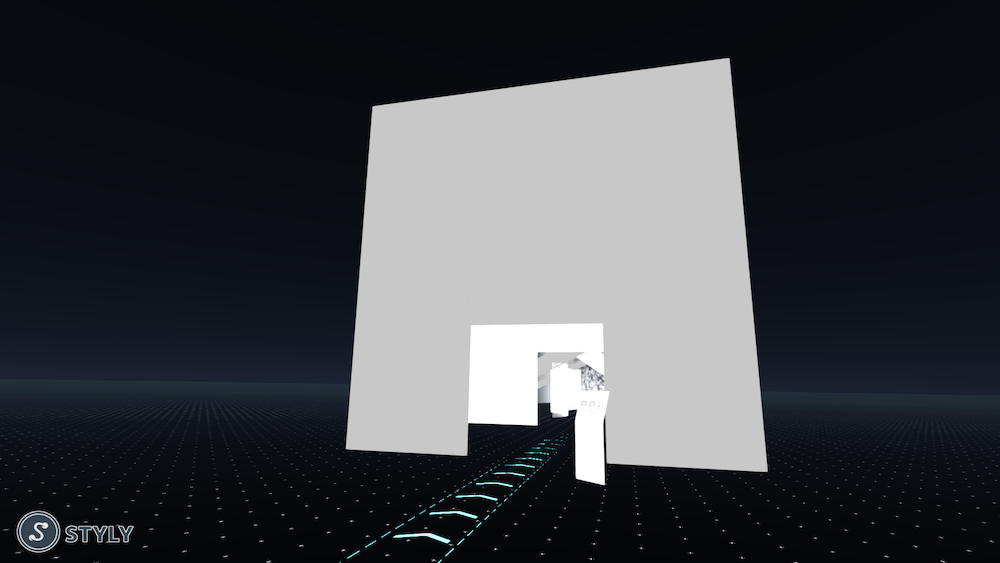
A simple box shaped virtual construction
These are simple ideal structures taken from the real world, but as I mentioned before, the space does not need to be completely separated. Let’s see what happens if we change the surface.
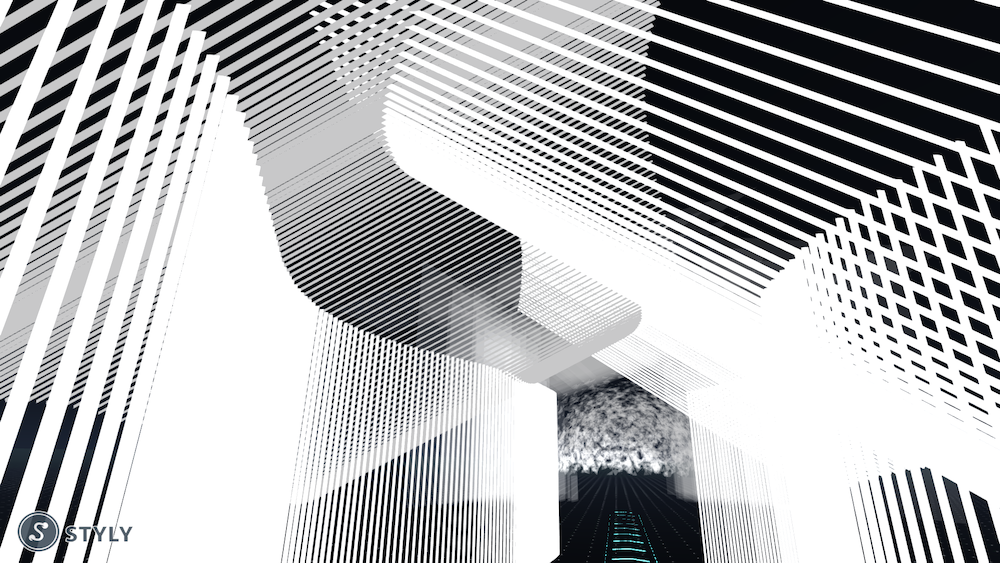
Use slits for the surface
A surface can separate the inside and the outside. But creating slits, and adding angles to a surface weakens this function.
This idea is used for louvers in the real world, but in VR this type of surface is used as boundaries, making it very unique.
Let’s look at another example that weakens the separating function of a surface. I have changed the transmittance. This will be very hard to do in reality, but in VR it can be adjusted by a simple slider.
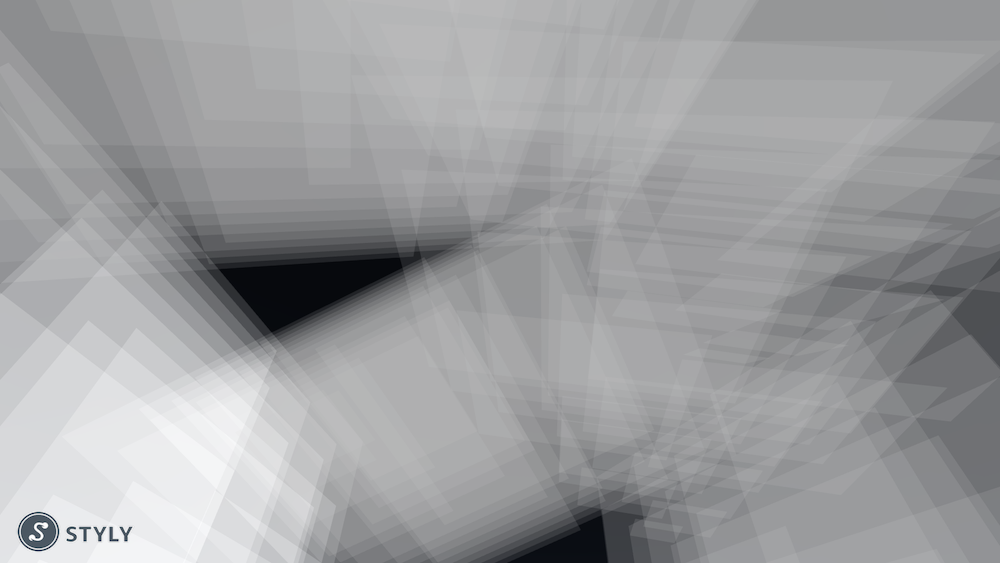
Controlling borders by changing the Transmittance
Another characteristic called intensity has been added to the walls. I think this is a very VRish technique. In worlds such as social VR, where visibility is a large factor, this technique could be important.
Lastly, please let me introduce computer generated structures.
This scene is created by randomly lit or shaded polygons.
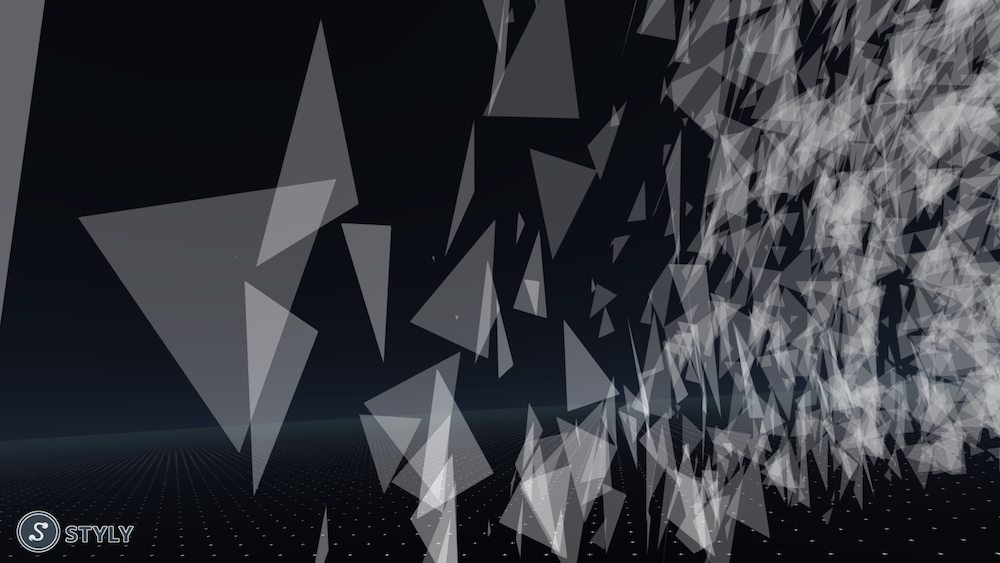
A space created by random surfaces
In this sample, the borders are very loose and obscure.
You can see that the boundary factor of surfaces are weakened in this scene. By fragmenting the surfaces this created very dispersed borders.
This was a simple sample, but I think you were able to take a glimpse at a new kind of spatial representation only possible in a virtual setting.
Exceeding Reality with Virtual Reality
As in my sample, in the virtual world, one can create spaces that cannot be created in reality very easily.
For the viewer, the space feels like a space, whether it is reality or virtual. It may be possible to create a truly rich and comfortable environment that nobody has ever seen before. Of course, I believe that one can gain precious experience and use it effectively in reality too.
You need to learn the basic functions of game engines, 3D modelling software, and the differences for each platform, but by that small effort you can start exploring the newest technology areas before anyone else.
I hope you will try building your very own ‘Virtual space’.
In the next article, I plan to talk about the relationship between visible and invisible. Make sure you don’t miss it!
